CORAL REEFS
Coral reefs are the most diverse and beautiful of all marine habitats. Large wave-resistant structures have accumulated from the slow growth of corals. The development of these structures is aided by algae that are symbiotic with reef-building corals, known as zooxanthellae. Coralline algae, sponges, and other organisms, combined with a number of cementation processes also contribute to reef growth.
The dominant organisms are known as framework builders, because they provide the matrix for the growing reef. Corals and coralline algae precipitate calcium carbonate, whereas the framework- building sponges may also precipitate silica. Most of these organisms are colonial, and the slow process of precipitation moves the living surface layer of the reef upward and seaward.
The reef is topographically complex. Much like a rainforest, it has many strata and areas of strong shade, cast by the overtowering coral colonies. Because of the complexity, thousands of species of fish and invertebrates live in association with reefs, which are by far our richest marine habitats. In Caribbean reefs, for example, several hundred species of colonial invertebrates can be found living on the undersides of platy corals. It is not unusual for a reef to have several hundred species of snails, sixty species of corals, and several hundred species of fish. Of all ocean habitats, reefs seem to have the greatest development of complex symbiotic associations.
Corals and Coral Reefs
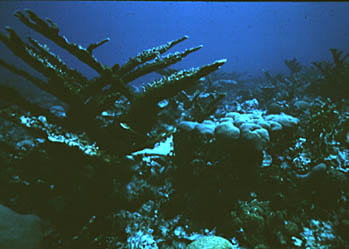
Branching and Mound-Shaped Corals, Jamaica 1970s. Photo by Phil Dustan
Reef-building corals may occur in a variety of growth forms, and there often is strong variation in coral shape even within a species. In this photograph, we can see the branching elkhorn coral Acropora palmata (upper left), with arms showing strong orientation into an oscillatory current between left and right. In the right foreground is the mound-shaped coral Montastrea annularis. It is of great interest that such differently shaped corals can occur side by side. What might that indicate to you?

Colony of elkhorn coral, Acropora palmata, Bonaire. Colony is about one meter across. Photo by Jeffrey Levinton

Colony of staghorn coral Acropora cervicornis, restored to shallow reef (2 m depth), Bonaire. Photo by Jeffrey Levinton
The complex variation of coral growth in the Caribbean genus Montastrea.
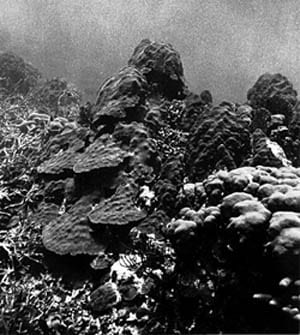
Intraspecific Variation in Growth Form
Here is an example of variation in coral growth. We see two colonies of “Montastrea annularis,” but one (center) is platy in appearance, whereas the other (right) is more mound-shaped. This photo is from the 1970s and since this time, we have learned that there are several species of Montastrea.
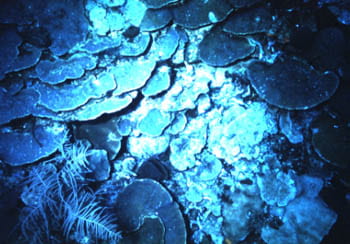
Deeper Water form of “Montastrea annularis“. Photo by Phil Dustan
In deeper waters (ca. 30 m) in the reefs of the north coast of Jamaica, one finds a greatly flattened species of Montastrea, which is a very close relative of the mound-building shallow water Montastrea annularis. The flattened mushroom-like shape may be an adaptation to capture light efficiently. These photos were taken in the 1970s. But there are, in fact, at least three species of Montastrea in the Caribbean. M. faveolota is found in the shallowest depths. M. annularis is found in intermediate depths. M. franksi are in deeper depths, although in truth all three species have strongly overlapping depth distributions. See Pandolfi and Budd, 2008. Marine Ecology Progress Series 369: 89-102. doi: 10.3354/meps07570.
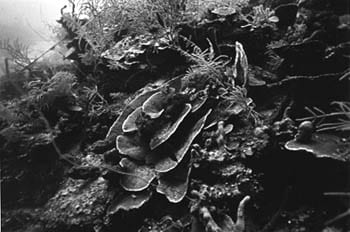
Plate-like Growth of Agaricia sp. Photo by Phil Dustan

Agaricia sp., Bonaire, photo by Jeffrey Levinton
By contrast, species of Agaricia tend to be plate-like in form and do not display nearly as much variation as some other dominant corals on the reef. A large fauna of sponges, bryozoans, articulate brachiopods, and other sessile epibenthic invertebrates live on the undersides of these platy corals.

Oriented branches of the elkhorn coral Acropora palmata, Jamaica, Discovery Bay, 1970s. Photo by Phil Dustan
Here we see the occurrence of a group of colonies of the elkhorn coral Acropora palmata, with arms conspicuously oriented left to right. This probably reflects a predictably strong bidirectional current. Because of the extensive growth plasticity of some corals, it is often difficult to distinguish between distinct biological species and plasticity of form within a species. These pictures were taken in Discovery Bay, Jamaica, before hurricanes and the death of a common sea urchin combined to greatly degrade the north coast Jamaican reef system in the early 1980s.

Platy Form of the Elkhorn Coral. Dancing Lady Reef, Jamaica, 1960s. Photo by Phil Dustan

Platy form of the Elkhorn Coral, Bonaire. Photo by Jeffrey Levinton
This shot of a reef on the north coast of Jamaica vividly captures the large amount of shade cast by the dominant elkhorn coral Acropora palmata. Because reef-building corals depend upon zooxanthellae for colony growth, the shaded areas are not good areas for vigorous coral growth, which depends upon light.
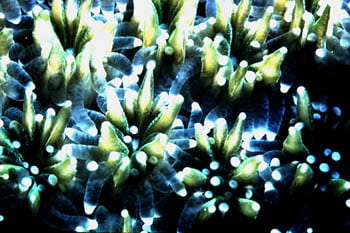
Hexacoral Polyps, Closeup. Photo by Robert Richmond
Hexacoral polyps (e.g., stony corals) have tentacles in groups of six. In hermatypic – or reef-building – corals symbiotic zooxanthellae are found within the endoderm and are usually concentrated in the tentacles, which increases exposure to light. The tentacles are also the site of enormous numbers of nematocysts, which can ensnare or puncture prey.
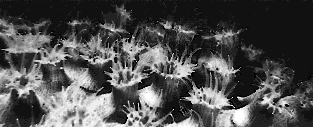
Polyps of Montastrea cavernosa. Photo by James W. Porter
This is a closeup of the massive scleractinian coral Montastrea cavernosa. The tentacles capture smaller zooplankton, by means of nematocysts.

Octocoral Polyps. Photo by Robert Richmond
Octocoral polyps (e.g., sea whips, sea fans) have 8 tentacles, instead of 6. Particles such as smaller zooplankton are probably captured by direct interception on the tentacles. In some cases, such as in sea fans, water streams around the colony and polyps capture particles in the quiet eddies that are formed on the downstream side of the colony.
Sponges

Sponges are another dominant sessile group found in coral reefs throughout the world, and often have lovely forms. They propel water through their bodies by means of flagellated chambers with flagellae. They have great species diversity of colony form.
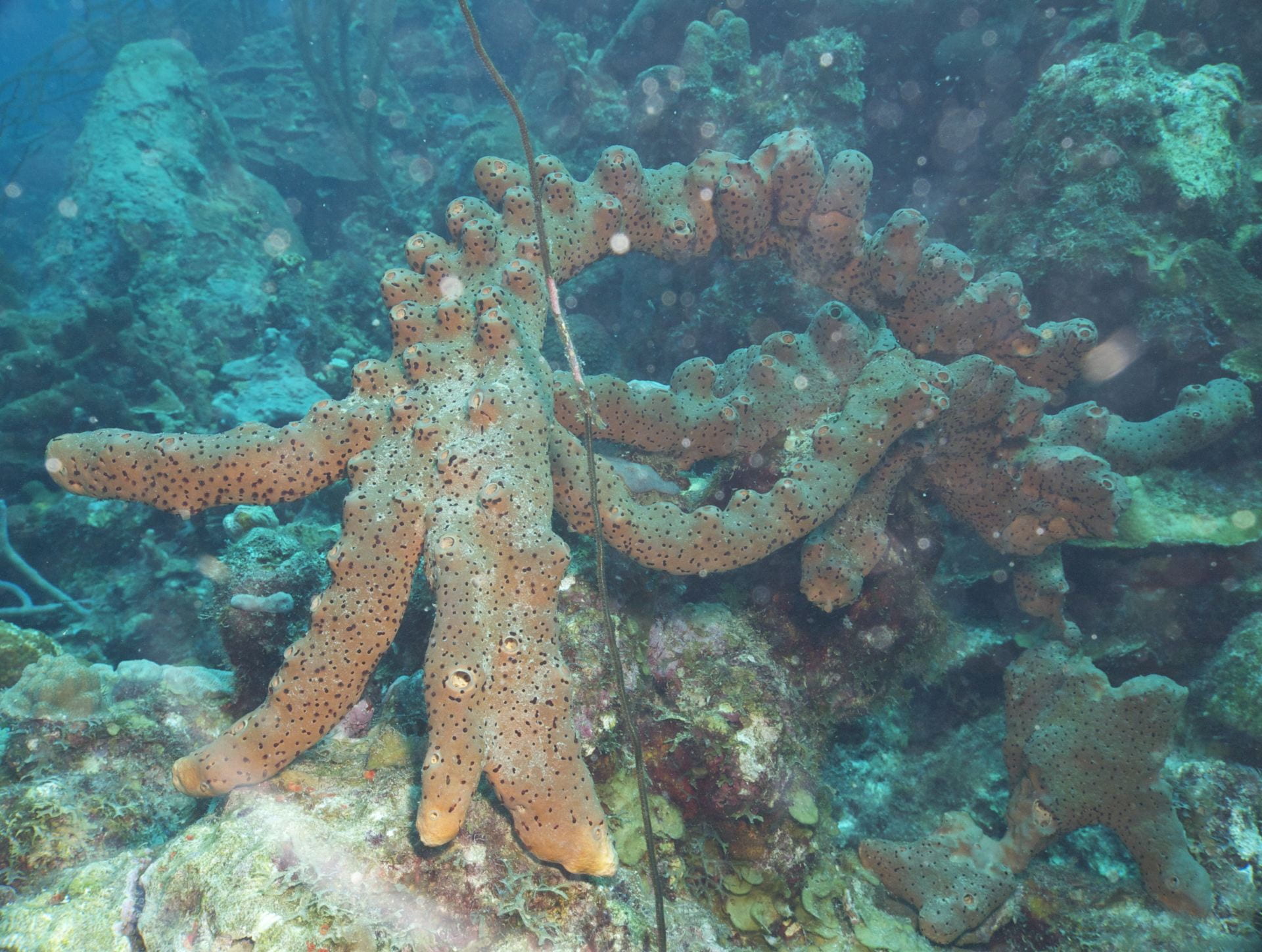



Some Caribbean sponges
Sponges are now the focus of research in coral reefs. Many believe that as corals decline, sponges will gradually ascend in dominance and become the space dominants of the future. But sponges cannot create the matrix of a coral reef that has been produced in the past by stony corals and their associate species. It therefore is not clear that coral reefs have much of a future as the magnificent diverse and wave resistant aggregate environments that we have come to know. It is worth asking whether coral reefs have a future at all if tropics-wide ocean warming continues.
Invasion and Explosions of the Crown-of-thorns Seastar
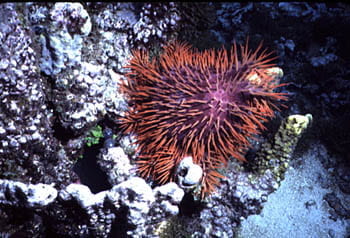
Crown-of-Thorns seastar, Acanthaster planci. Photo by Robert Richmond
Acanthaster planci is a Pacific Ocean coral reef-associated carnivorous asteroid seastar whose principal prey are corals. It has sharp dorsal spines that penetrate human skin and cause sickness. Normally it occurs at low density and is nocturnal. In the 1960s, population explosions were found all over the Indo-Pacific and the starfish were moving in large numbers during the day. Instead of being of minor impact, they were now major predators on the reef. In Guam, for example, over 90% of the corals were killed. The explanation of the origin of the outbreaks is still very controversial. Charles Birkland suggested that they were related to storms that could wash out nutrients from atolls, which stimulated phytoplankton growth, which, in turn, increased the survival of seastar planktotrophic larvae. Others have argued that larval starvation is not a limiting factor in larval survival. It was also argued that typhoons and other storms killed corals, causing starvation among the starfish and a switch to roving in aggregations in search of food. Most recently it has been argued that overfishing for finfish has resulted in reduced predation on juvenile starfish, resulting in the explosion of seastar populations. COT starfish eruptions continue throughout the Pacific.
Pacific shallow reefs are often dominated by the the erect coral Pocillopora damicornis. When the crown-of-thorns seastar tries to mount and consume the coral, several species of shrimps and crabs that live among the coral branches move to attack the seastars, thus defending the coral.
Atolls


Atoll. Photos by Robert Richmond
An atoll is a ring- or horseshoe-shaped group of islands, surrounding a lagoon. Coral reefs line the inner and outer parts of the island. Darwin hypothesized that the earth’s crust was slowly sinking, and that corals were growing upward and keeping up with the overall sinking rate. At first, a submarine volcano might be jutting out into the sea, but sinking led to the ring of coral reefs around the volcano to grow upwards and form the islands. While most agreed with this hypothesis, the geologist Harry Ladd confirmed it by leading a drilling team to this region. The team drilled through hundreds of meters of coral reef rock before reaching volcanic rock below of Eocene age. Atolls are found in the Pacific but are also present in the Caribbean basin. In contrast to atolls, coastal reefs fringe many large land masses, such as Central America and Australia.
Interspecies relations on the reef
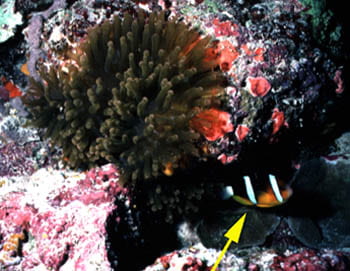
Clownfish with Anemone. Photo by Robert Richmond
The arrow points to a clownfish, Amphiprion clarkii, one of many members of the fish family Pomacentridae. Clown fish maintain a fascinating mutualism with sea anemones and may even lie within the anemone’s tentacles. The fish gradually picks up some of the mucus from the tentacles and the anemone eventually fails to recognize the fish as prey or as an intruder.

Clown Fish Among Anemone Tentacles. Photo by Don Hesler

Photo by Don Hesler
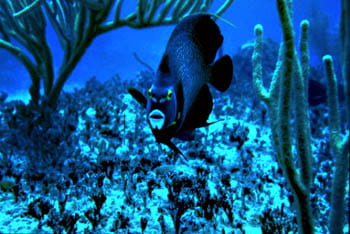
French Angel Fish. Photo by Jean Billerbeck

French angel fish, Pomacanthus paru, Bonaire. photo by Jeffrey Levinton
This shot was taken on a Caribbean coral reef. Pomacanthus paru is quite common and reaches lengths of 30 cm or more. The French Angel feeds mainly on sponges.

Bluehead Wrasse, Thalassoma bifasciatum, Bonaire, Caribbean. Photo by Jeffrey Levinton
Terminal male phase of bluehead wrasse, Thalassoma bifasciatum, Bonaire. Usually less than 120 mm in length and feed on small invertebrates. Small individuals may be females or initial phase males, and can change into the terminal phase, which is a dominant male.
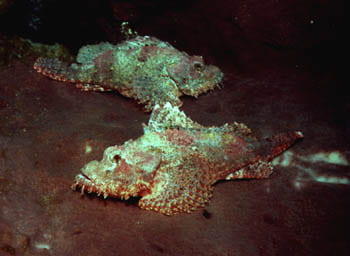
Stonefish, Thailand. Photo by Don Hesler
The Indo-Pacific Stone Fish, Synanceja horrida, is a member of the family Scorpaenidae and lives cryptically beneath rocks and within crevices. Its dorsal spines are deadly and inject stonustoxin, one of the most virulent toxins in the world, which causes hypotension and respiratory difficulties and is commonly fatal to those people who step on them. The toxin affects neuromuscular junctions.
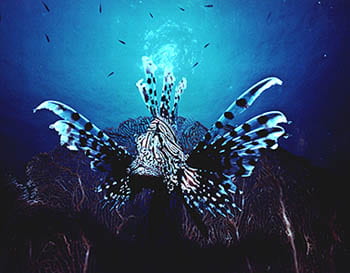
Lionfish, Thailand. Photo by Don Hesler
The Pacific lionfish, Pterois miles, is also a member of the family Scorpaenidae and also has toxic spines, but is far more visible than the Stone Fish, to the degree that it appears that it is “advertising” its presence by means of bright coloration. Its spine tissue contains acetylcholine and a toxin that affects neuromuscular transmission. Nevertheless it does have some successful predators, including the cornetfish, Fistularia commersonii. In the 1970s two species of lionfish invaded the Caribbean, thanks to releases from aquaria in Florida. These have spread rapidly throughout the Caribbean and have caused a great deal of damage as novel predators on many local fish species. Attempts to hunt lionfish have been only modestly successful.

Invasive lionfish, Pterois voilitans, at about 15 m depth on a coral reef on Bonaire, southern Caribbean. This species is a major predator of smaller fishes on the reef and is actively hunted. Photo by Jeffrey Levinton, 2014

Filament-tipped Prawn Goby, Thailand. Photo by Don Hesler
Many species of goby in tropical sands burrow and share their burrow with a mutualistic shrimp. The associations are species-specific. Typically the shrimp burrows and maintains the burrow, while the goby guards against mobile predators. This species, Stonogobiops nematodes, usually occurs in pairs in sandy bottoms deeper than 15 m, and lives in association with an Alpheus shrimp.
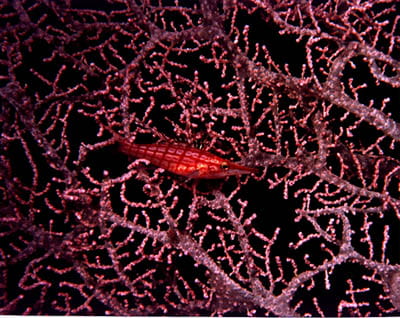
Photo by Don Hesler.
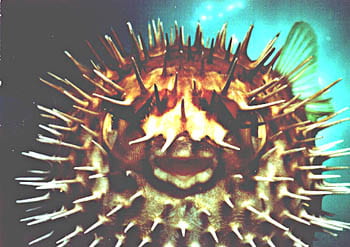
Porcupinefish. Photo by Don Hesler
When confronted by a predator, the porcupinefish can inflate its body, which projects a prickly surface of spines. This species has a pair of specialized jaws that are used to crush hard prey, such as mollusks.

Oriental Sweetlips, Thailand. Photo by Don Hesler
Oriental Sweetlips, Plectorhinchus vittatus, occur as adults in seaward reefs or in clear open lagoons. The juveniles are found in more protected areas. Adults usually occur individually, but may be found in schools.

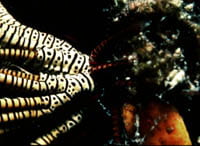

Feather Star, Cenometra bella
Feather stars (comatulid crinoids, Class Echinodermata) are prominent and lovely features of coral reefs, although they also occur in higher latitudes. Most conspicuous are the arms, which are festooned by pinnules, which, in turn, bear tube feet that capture small zooplankton by direct interception. The upper right photo shows the cirri, which can grip the substratum. The upper left photo shows the disposition of the pinnules in a plane, which probably corresponds to the location of the feather star (bottom) in open habitats, which are often subjected to unidirectional currents.
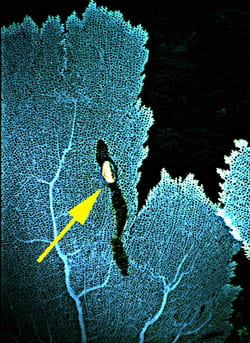
Snail Cyphoma gibbosum on a Sea Fan. Photo by Robert Richmond

Cyphoma gibbosum feeding on gorgonian, Bonaire. Photo by Jeffrey Levinton
Species of the carnivorous gastropod Cyphoma occur in the Caribbean. They are often carnivores on octocorals, such as the sea fan, Gorgonia ventalina, shown at left. They leave a characteristic grazing trail of dead coral tissue. In the Carribean, Cyphoma gibbosum are notable for being preda- tors of the gorgonian Plexaura homomalla, which has very high concentrations of secondary compounds that deter many other species of predators. The snail consumes the tissue, and has high concentrations of some detoxifying compounds. C. gibbosum is a generalist and preys on a number of different prey species, each of which is armed with differing anti-predator compounds. Catherine Van Alstyne and Nancy Targett showed that the sea fan pictured at left harbors compounds that strongly reduce the feeding rate of C. gibbosum, but obviously do not stop predation completely.
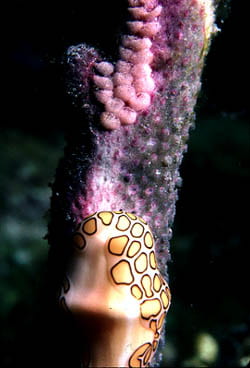
Egg-Laying by Cyphoma gibbosum on Octocoral. Photo by Drew Harvell
This photo shows a female flamingo tongue Cyphoma gibbosum, with eggs that she has laid on an octocoral that she just fed upon and stripped off the tissue. This demonstrates an interesting relationship that is common among carnivorous invertebrates: the source of food may also be a substratum for egg laying. Why is such behavior only likely when a colonial species is the prey?
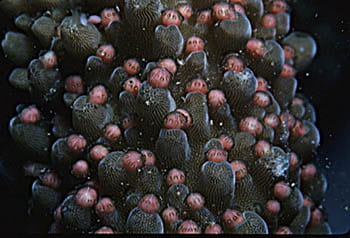
Coral Acropora sp. Spawning
This shot shows a Pacific Acropora colony spawning. You can see the pink egg packets emerging. Mass spawning has proven to be one of the most exciting coral reef discoveries in recent years. In the Great Barrier Reef of Australia and at the Flower Gardens off the coast of Texas, many species of coral have been observed to spawn during the same night. This is a response to lunar cycles and ensures a maximum of fertilization success for each of the species independently.
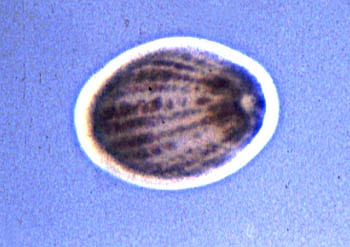
Coral Planula Larva. Photo by Robert Richmond
Planula larvae of reef-building corals are as yet very poorly known ecologically. It is not clear as yet how far they travel and what mechanisms they employ to locate suitable sites upon which to settle. Robert Richmond was interested in the apparent widespread distribution of the coral Pocillopora damicornis, which extends from Africa to Panama. He found that planula larvae could be kept alive in a laboratory container for over 100 days and then they were competent to settle and metamorphose. This implied that the larvae could survive a trip over the greatest expanse of the Pacific between distant sites of land.
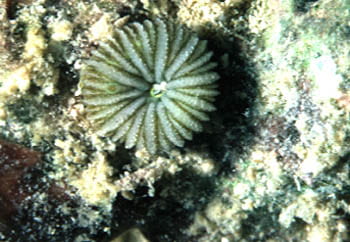
Newly Settled Coral. Photo by Robert Richmond
The pioneering work of Paul Sammarco demonstrated that coral larvae, despite their potential long life in the plankton, may not be traveling very far from their point of origin. Using settling plates around a patch reef, newly settled coral colonies like the one at left were collected. Using a model based upon measurements of local currents, settlement was predicted to occur in great concentrations in a few spots on the patch reef, which was confirmed with recruitment studies. Settling plates demonstrated that larvae did not go far from the patch reef before they settled.
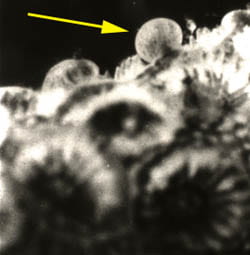
Polyp Bailout. Photograph by Paul W. Sammarco
Paul Sammarco and Robert Richmond discovered that polyps, even after secreting a calcareous skeleton can “bailout,” and swim into the water. This can occur, for example, just after a planula larva has settled, metamorphosed, and secreted a skeleton. The bailout occurs in response to poor conditions, such as poorly oxygenated water.
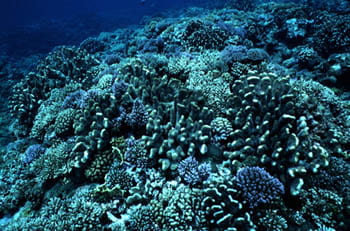
Patch Reef in Guam. Photo by Robert Richmond
This photograph of a patch reef shows the complexity of species coexistence, even if we cannot exactly identify all of the species. As discussed in the text, coral competitive interactions are diverse and result in a good deal of complexity in the outcome of competition and succession.
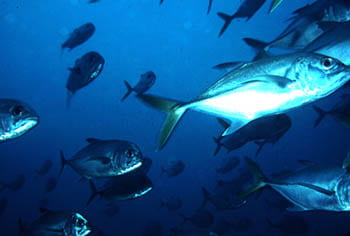
Jacks. Photo by Robert Richmond
This shot was taken on a coral reef in the Grenadine Islands, Caribbean Sea. Jacks are swift-swimming carnivores, usually feeding on other fish.
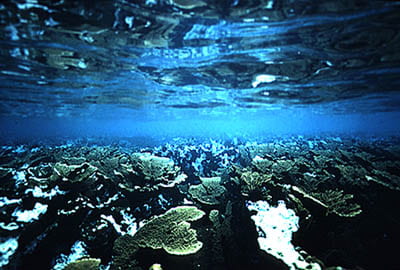
Reef Crest, Discovery Bay, Jamaica, 1970s. Photo by Phil Dustan
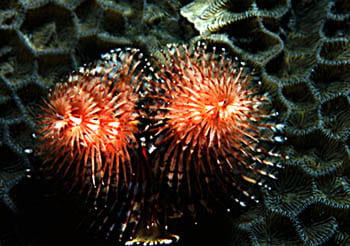
Serpulid Growing in Coral. Photo by Robert Richmond
These polychaetes secrete a calcareous tube and have a crown of ciliated tentacles that collect particles from the water column. The worm has a conical operculum that can seal off the tube when the worm withdraws.
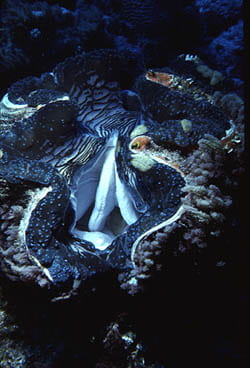
“Killer Clam” Tridacna gigas. Photo by Robert Richmond

Tridacna gigas, Beaver Cay, Great Barrier Reef. Photo by Jeffrey Levinton
You can see from above the fleshy parts of the so-called killer clam. Tridacna species are bivalves that maintain an exquisite symbiosis with algae known as zooxanthellae. These microorganisms, dinoflagellates actually, also occur in many other groups including corals and sea anemones. As in the other cases, the zooxanthellae transfer dissolved carbon to the animal host, which benefits from the nutrition. Many species of Tridacnas also suspension feed, and there is a good deal of variation in the proportion of energy derived from zooxanthellae, versus feeding upon suspended food (i.e., phytoplankton).
The Role of Urchins in Coral Reef Ecology
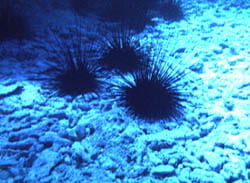
Caribbean Urchin Diadema antillarum
Diadema antillarum is a common urchin in the Caribbean, or at least it was until a disease drove it to near extinction in the late 1980s. The picture above at left shows the stark white landscape left by urchin grazing. In the Caribbean, grazing of algae by urchins and herbivorous fish helped keep seaweed populations down, but overfishing of finfish led to reductions of fish grazing, so by the 1970s, most grazing on coral reefs was done by urchins such as D. antillarum. This made the urchin disease all the more significant since there was no longer any significant grazing activity on many coral reefs, leading to overgrowth by algae. This was especially crucial on coral reefs of Jamaica, where a series of hurricanes caused much destruction of coral reefs, which interacted with algal overgrowth to cause much reef destruction. An influx of diseases, likely associated with ocean warming, has made the plight of many Caribbean coral reefs only more dire.
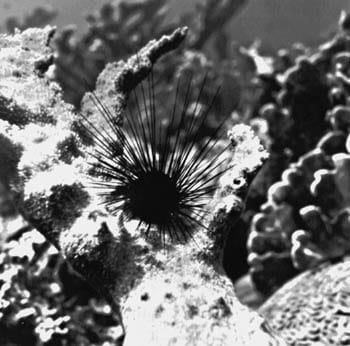
Diadema antillarum. Photo by James W. Porter
Diadema antillarum feeds on fleshy algae, but also can feed on many species of sessile invertebrates, including juvenile corals. Hence, this urchin can influence coral recruitment and relative abundance. The urchin often spends time in crevices of patch reefs during the day, but forages at night on surrounding seagrass beds. In 1983-1984 a poorly understood disease spread throughout the Caribbean and killed off nearly all these urchins. In places where overfishing had been common, these urchins were the last grazer that kept corals from being overgrown by algae, so the die-off was extremely detrimental to coral survival on reefs.

Urchin-Caused Patch Reef Halos. Photograph by Thomas Suchanek
The urchin Diadema antillarum was a major grazer on patch reefs in the Caribbean until a disease nearly eliminated them in 1983-4. They hide in crevices within the patch reef during the day, and John Ogden and students showed that they move outward at night, grazing on turtle grass. The figure at left is an air photo of some patch reefs. The arrows point to halos devoid of grass that formed around the patch reefs.
Interspecific Competition on Coral Reefs
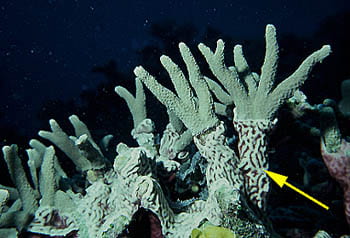
Ascidian Overgrowing Coral. Photo by Robert Richmond
Cases of interspecific competition are rampant on coral reefs but the example at left is unusually graphic. An ascidian is growing upward and engulfing a branching coral. One study demonstrated that such overgrowths can be initiated by detection of the superior competitor of odors that emanate downstream from the competitively inferior victim. In effect, the ascidian (arrow) is locating and climbing a high substratum, presumably to protrude its suspension-feeding zooids into the mainstream current.

Scolymia lacera digesting S. cubensis. Photo by Judith Lang Land
Scleractinian corals can win in competition merely by growing over their competitors. Thomas and Nora Goreau discovered, however, that the fastest-growing corals were not necessarily the most abundant. Apparently, corals have a variety of other competitive mechanisms. Here we see one of them. Scolymia lacera is a small coral that resists overgrowth by extending digestive filaments outward and literally digesting a competitor. Another massive and relatively slow-growing coral, Montastrea annularis, has long sweeper tentacles that can inject nematocysts into adjacent competing colonies.
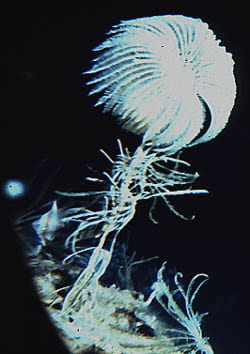
Photo of Deep-water Stalked Crinoid, Jamaica. Photo by David L. Meyer
Deep sites greater than 75-100 m cannot be studied effectively by surface-originated SCUBA diving. The picture at left was taken from the NEKTON submarine off the north coast of a Jamaican reef at depths between 600 and 800 m. Stalked crinoids are suspension feeders with an umbrella-like array of arms, which are festooned with tube-feet. Smaller zooplankton are captured by tube feet and transferred on ciliated tracts to the mouth. The body is connected to the substratum by means of a stalk, which consists of a stack of calcium carbonate plates. Stalked crinoids were very common in Paleozoic seas, but they are rather rare today.
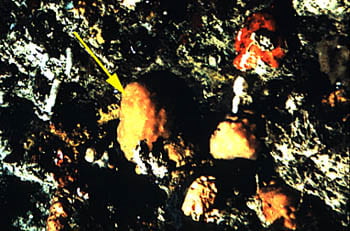
Sclerosponges, Deep Reef of Discovery Bay, Jamaica. Photo by David L. Meyer
One of the most exciting discoveries made on a deep reef was the discovery of the sclerosponge Ceratoporella nicholsoni on the deep reefs near Discovery Bay, Jamaica in the West Indies. This sponge (arrow) produces a calcareous skeleton, and is reminiscent of a long-extinct group of Paleozoic sponges.
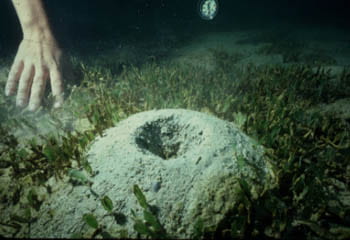
Callianassid Shrimp Sediment Mound, Jamaica. Photo by Thomas Suchanek
Quiet water areas around coral reefs are mantled with soft sediment. This mound is produced by the burrowing activities of callianassid shrimp, who produce complex burrows that have many chambers and may join with the burrows of other shrimp. The shrimp are suspension and detritus feeders.
Coral Reefs in Peril, and Their Restoration
Throughout the world coral reefs are in decline, owing to global ocean warming. Heat stress has caused a phenomenon known as bleaching, where symbiotic zooxanthellae are lost from the corals, leaving a pale white color.
Coral Bleaching

Coral Bleaching. Photo by Robert Richmond
Unfortunately, more and more corals are being encountered that are bleached. The bleaching is due to the absence of symbiotic zooxanthella algae, which are expelled from the coral under stress. In some cases, bleaching can be associated with overly warm sea temperatures, especially those associated with el Ninos arriving at the Pacific coast of Panama. In 1995, bleaching was associated with warm temperatures (over 30 degrees C) in the Gulf of Mexico. Bleaching has been common throughout the coral reefs of the world. In many cases the bleaching is temporary, occurring in a warm summer, or during an El Nino, but as climate change warms the ocean, bleaching events increase and interact with the occurrence of a variety of diseases, which change in character in time and space.
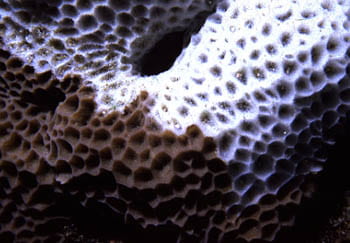
Closeup of Coral Bleaching.
Large-scale bleaching was more or less unknown before the 1970s but bleaching events have spread throughout coral reefs in the whole world tropics. Bleaching events are usually associated with region ocean warming. Periodic events such as El Ninos interact with the longer-term warming arising from climate change, caused by human additions of greenhouse gases to the atmosphere, since the industrial era began.
El Nino events exacerbate the overall global warming trend and have caused major bleaching events, as in Pacific Panamanian reefs in the 1982 El Nino event. But warming events, such as in 2005 in the Caribbean, and 2015 in the southern Great Barrier Reef, have caused major bleaching events.

Map showing extent of bleaching on the Great Barrier Reef in 2015, from ARC Center of Excellence, Australia

Bleached corals, Great Barrier Reef, 2015, courtesy of ARC Centre of Excellence, Australia. Thanks to Terry Hughes.
Most alarming are worldwide warming events, that have spread the dangers of heating and bleaching to coral reefs around the world. In the past few decades these events appear to have been more frequent. Since 2023, a global event has presented danger and widespread bleaching. Areas formerly remote from these dangers, such as Bonaire in the southern Caribbean basin, have been experiencing bleaching events.
Coral Disease
Warming has also facilitated the spread of coral diseases, which have been especially lethal in Caribbean reefs. While a number of diseases have been very damaging, in recent years the appearance of Stony Coral Tissue Loss Disease has been especially a problem for Caribbean coral, and is believed to be a bacterial pathogen. As a final blow, overfishing has reduced grazing of algae on reefs, resulting in overgrowth and degradation of reefs. Coral reefs are on the precipice of major declines throughout the world.

Coral Restoration Efforts
Coral reefs are in great peril throughout the globe, owing to the combined effects of overfishing, ocean warming, and other human impacts on coral reefs. The decline of coral reefs has been especially strong in the Caribbean, but has also been a major problem throughout the world. Because of declines, there has been a strong effort to restore and conserve reefs. On Bonaire, Netherland Antilles, a number of notable efforts have been made to reduce the impact of fishing and divers on reefs and to propagate corals and plant them in areas where corals have diminished in abundance, keeping in mind that Bonaire is still one of the most thriving coral regions in the Caribbean. Restoration efforts in Bonaire have followed the pioneering work of the Coral Restoration Foundation, whose operations began in the Florida Keys. Research has emphasized growth of coral fragments, studies of the genetic basis of coral growth and the value of coral genetic diversity, and propagation of a variety of species.
Coral fragments are being grown on coral nursery trees, where corals feed on zooplankton in the middle of the water column. In some cases, this has involved an effort to maximize genetic diversity of corals for planting. Most emphasis has been on staghorn and elkhorn corals in the Caribbean basin.
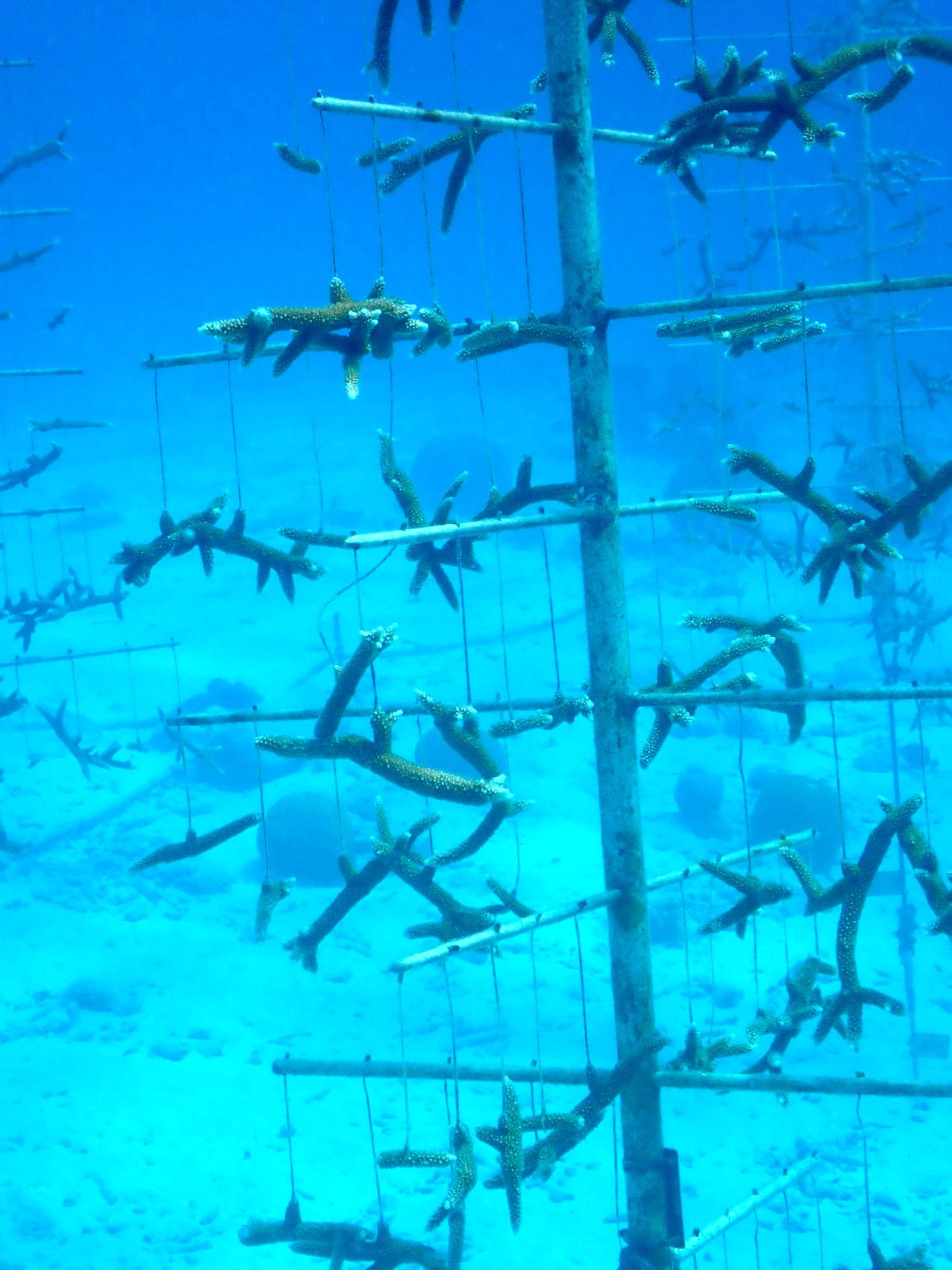
Closeup of fragments of staghorn coral, Bonaire, Caribbean.
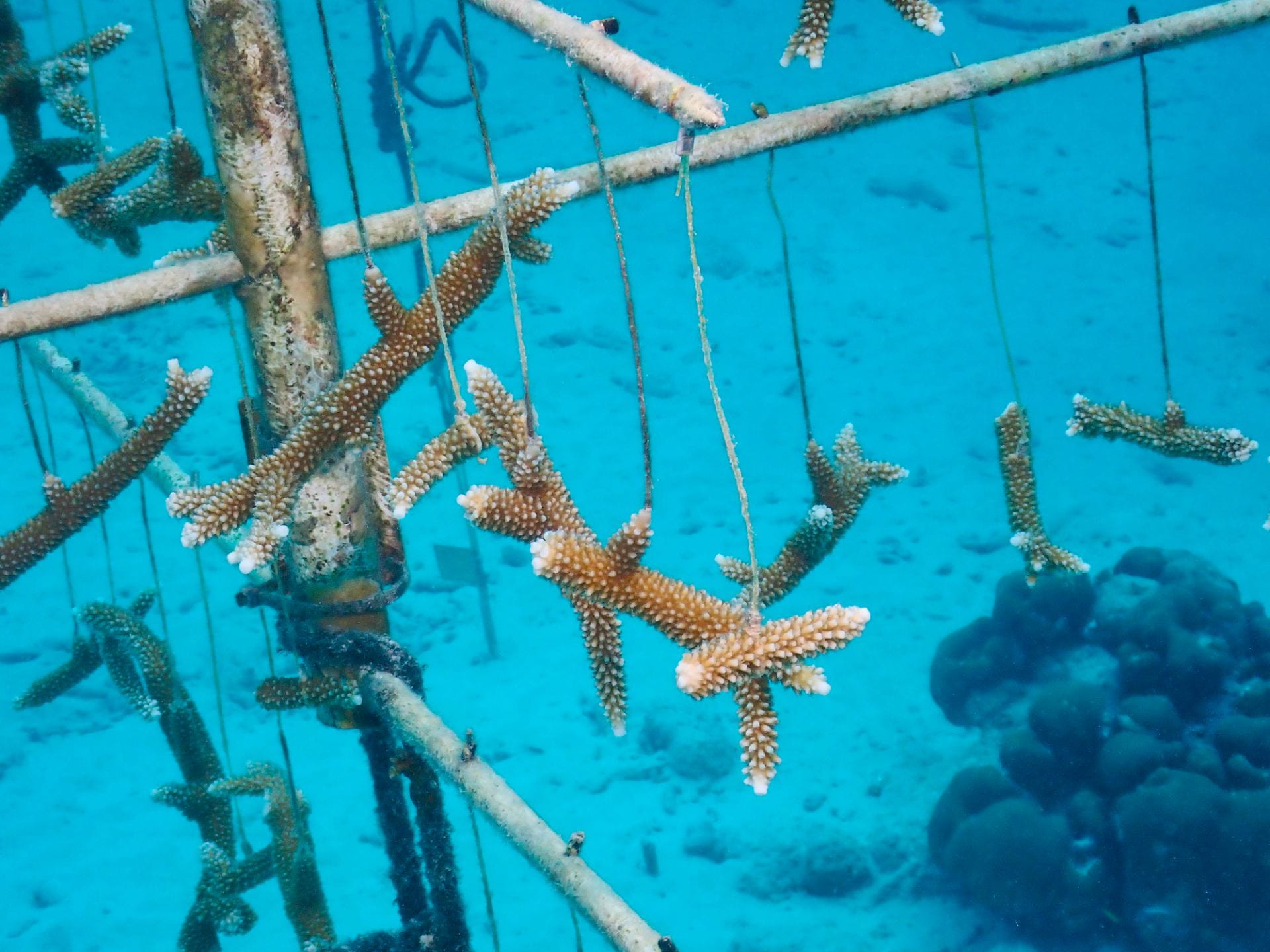
After a few years, fragments planted on frames extend and grow into
rich coral colonies, and attract fish and other associated organisms, increasing
local diversity.

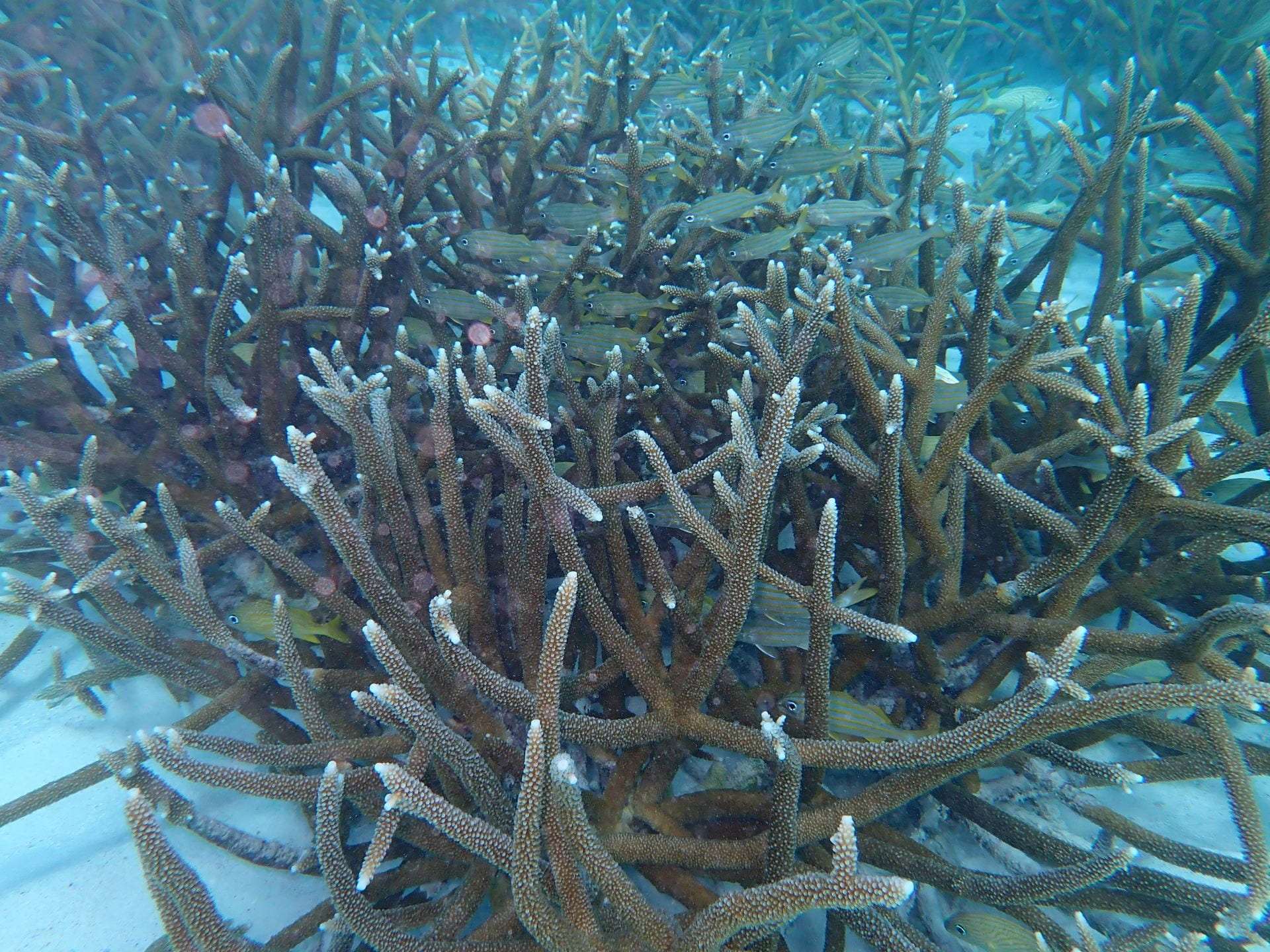
Staghorn coral restoration: Buddy Dive house reef, Bonaire Staghorn coral restoration, Jefferson Davis dive site, Bonaire
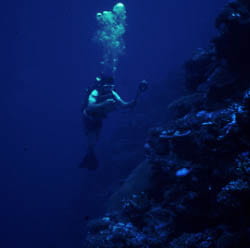
Diving and Reef Photography. Photo by Robert Richmond
We must continually pay our homage to the many coral reef researchers who have put in so much diving time to understand their environment. Thomas F. Goreau was a great pioneer in scientific SCUBA diving and began his work on the coral reefs of Jamaica in the 1950s, not long after SCUBA was invented. See MBESSAY “Letter from Bonaire” about the current state of corals and diving in the Caribbean.
